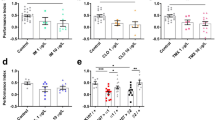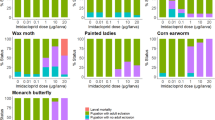Abstract
Synthetic pyrethroids are a new class of highly active insecticides with great potential for practical application1. They are generally recognized as neurotoxicants that act directly on excitable membranes2,3. Previous studies have shown that the effect of the pyrethroid allethrin closely resembles that of the classical insecticide dichlorodiphenyl trichloroethane (DDT) in the peripheral nervous system of Xenopus laevis4,5. Both compounds induce intense repetitive activity in sense organs and in myelinated nerve fibres. In the lateral-line sense organ this repetitive activity increases with cooling, a phenomenon that may be related to the negative temperature coefficient of toxicity of DDT6 and pyrethroids7 in insects. In frog node of Ranvier, DDT slows the closing of sodium channels that open during depolarization8,9 so that a prolonged sodium tail current persists after the membrane has been repolarized. We have recently found that the pyrethroid allethrin10 causes a similar sodium tail current in the nodal membrane of Xenopus. Pyrethroids11,12 and DDT13,14 are also known to cause prolongation of the sodium current together with repetitive activity in nerve fibres of invertebrates. The prolonged sodium current is thought to be directly responsible for this repetitive activity3,15, and it has been suggested that the sodium channel in the nerve membrane is the major target site of pyrethroids and DDT-like compounds10,12. We have now investigated the mechanism by which pyrethroids and DDT prolong the sodium current in Xenopus nodal membrane. Our results show that these compounds—despite marked differences in chemical structure—modify sodium channel gating in a strikingly similar way and reduce selectively the rate of closing of the activation gate.
This is a preview of subscription content, access via your institution
Access options
Subscribe to this journal
Receive 51 print issues and online access
$199.00 per year
only $3.90 per issue
Buy this article
- Purchase on Springer Link
- Instant access to full article PDF
Prices may be subject to local taxes which are calculated during checkout
Similar content being viewed by others
References
Elliott, M., Janes, N. F. & Potter, C. A. Rev. Ent. 23, 443–469 (1978).
Narahashi, T. in Insecticide Biochemistry and Physiology (ed. Wilkinson, C. F.) 327–352 (Plenum, New York, 1976).
Wouters, W. & van den Bercken, J. Gen. Pharmac. 9, 387–398 (1978).
van den Bercken, J., Akkermans, L. M. A. & van der Zalm, J. M. Eur. J. Pharmac. 21, 95–106 (1973).
van den Bercken, J., Kroese, A. B. A. & Akkermans, L. M. A. in Neurotoxicology of Insecticides and Pheromones (ed. Narahashi, T.) 183–210 (Plenum, New York, 1979).
Eaton, J. L. & Sternburg, J. J. Insect Physiol. 10, 471–485 (1964).
Harris, C. R. & Kinoshita, G. B. J. econ. Ent. 70, 215–218 (1977).
Hille, B. J. gen. Physiol. 51, 199–219 (1968).
Årnhem, P. & Frankenhaeuser, B. Acta physiol. scand. 91, 502–511 (1974).
van den Bercken, J. & Vijverberg, H. P. M. in Insect Neurobiology and Pesticide Action, 79–85 (Society of Chemical Industry, London, 1980).
Narahashi, T. Pestic. Sci. 7, 267–272 (1976).
Narahashi, T. & Lund, A. E. in Insect Neurobiology and Pesticide Action, 497–505 (Society of Chemical Industry, London, 1980).
Narahashi, T. & Haas, H. G. J. gen. Physiol. 51, 177–198 (1968).
Pichon, Y. & Boistel, J. J. Physiol., Paris 61, 373–374 (1969).
van den Bercken, J. Eur. J. Pharmac. 20, 205–214 (1972).
Dodge, F. A. & Frankenhaeuser, B. J. Physiol. Lond. 143, 76–90 (1958).
Hodgkin, A. L. & Huxley, A. F. J. Physiol., Lond. 116, 500–544 (1952).
Chiu, S. Y. J. Physiol., Lond. 273, 573–596 (1977).
Dubois, J. M. & Bergman, C. Nature 266, 741–742 (1977).
Vijverberg, H. P. M. & van den Bercken, J. Eur. J. Pharmac. 58, 501–504 (1979).
Farnham, A. W. Pestic. Sci. 8, 631–636 (1977).
Sawicki, R. M. Nature 275, 443–444 (1978).
Hille, B. J. gen. Physiol. 69, 497–515 (1977).
Dodge, F. A. thesis, Rockefeller Inst. (1963).
Author information
Authors and Affiliations
Rights and permissions
About this article
Cite this article
Vijverberg, H., van der Zalm, J. & van den Bercken, J. Similar mode of action of pyrethroids and DDT on sodium channel gating in myelinated nerves. Nature 295, 601–603 (1982). https://doi.org/10.1038/295601a0
Received:
Accepted:
Issue Date:
DOI: https://doi.org/10.1038/295601a0
This article is cited by
-
Drosophila ecdysone receptor activity-based ex vivo assay to assess the endocrine disruption potential of environmental chemicals
Environmental Science and Pollution Research (2022)
-
Dengue fever and insecticide resistance in Aedes mosquitoes in Southeast Asia: a review
Parasites & Vectors (2021)
-
Association between urinary 3-phenoxybenzoic acid and body mass index in Korean adults: 1st Korean National Environmental Health Survey
Annals of Occupational and Environmental Medicine (2016)
-
Kinetics of olfactory responses might largely depend on the odorant–receptor interaction and the odorant deactivation postulated for flux detectors
Journal of Comparative Physiology A (2013)
Comments
By submitting a comment you agree to abide by our Terms and Community Guidelines. If you find something abusive or that does not comply with our terms or guidelines please flag it as inappropriate.



